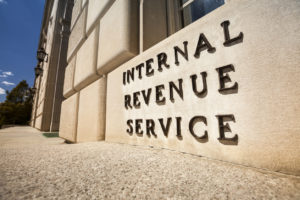All lawyers know something about taxes: we all pay them, and we all know that legal fees are income. In fact, legal fees are ordinary income, and are even subject to self-employment taxes. Lawyers occasionally try to argue that legal fees are capital gains, but that is an awfully tough sell with the IRS. So, you must figure that you will be paying full freight in taxes on your legal fees, no matter what.
But what about timing? Much in the tax law is about timing. In general, a classic tenet of tax planning is to try to defer income and to accelerate deductions. For generations, tax lawyers have explored all manner of tax deferral strategies, so there are many decades of tax lore to draw from.
According to the IRS, you have income for tax purposes when you have an unqualified, vested right to receive it. Asking for payment later doesn’t change that. The idea is to prevent taxpayers from deliberately manipulating their income. The classic example is a bonus check available in December, where the employee asks to have the employer hold it until January 1. You might think that normal cash accounting suggests that the bonus is not income until paid. But the employer tried to pay in December and made the check available. To the IRS, that makes the bonus income in December, even though it is not collected until January.
Lawyers are subject to these rules just like everyone else, but there is a surprising exception for contingent fee lawyers. Plaintiff lawyers often lament the unpredictability of their own income. They may also lament the need to resort to borrowing to finance their cases. In some cases, plaintiff lawyers complain that they cannot take the cases they really want to take, given the financial realities of contingent fee practice.
However, plaintiff lawyers can actually use a benefit most other people—including other lawyers—can’t: structured legal fees. Reduced to simplicity, the concept of structured legal fees is a kind of tax-advantaged installment plan that doesn’t rely on the credit worthiness of either the defendant or the client. Like much else that is tax-advantaged, this exception has some rigidity. Yet it involves a tried-and-true tax structure that works, and it is grounded in economic reality.
In essence, the contingent fee lawyer can decide before settlement that instead of taking a contingent fee upon settlement of the case, he wants that fee paid over time. The lawyer must decide to do this before the case settles—but that can be right before it settles, even the night before. As a practical matter, the lawyer has “earned” his contingent fee over the course of the case. Yet the tax authorities say that the lawyer hasn’t technically earned his fee for tax purposes until the settlement documents are actually signed.
Amazingly, the attorney can have complete discretion whether to structure all of his fee or a percentage of it. The tax case uniformly cited as establishing the bona fides of attorney fee structures is Childs v. Commissioner, 103 T.C. 634 (1994), affirmed without opinion 89 F.3d 56 (11th Cir. 1996). For a few years, there was concern that the IRS might disagree with contingent fee structures despite the Childs case. But over the last several decades the IRS has often favorably cited Childs.
But care is still needed when using structured legal fees. The settlement agreement must call for it, and no lawyer wants to rely on the defendant to pay the fees over time. So frequently the settlement agreement requires the defendant to pay the full amount to a third party, which then distributes the payments over time to the plaintiff lawyer. In the early days of structured fees, the third party was invariably a life insurance company that funded annuities for the benefit of the lawyer. Then the annuity payments would be taxed over time.
Although annuities still work fine today, most lawyers seem to want a better return than life insurance annuities, so most structured fees today are done with a portfolio of stocks and securities. Whether the structure is done with annuities or securities, the format and documents are important. The plaintiff lawyer can’t own the annuities or the securities, but instead is the named payee of the structure.
But what if you don’t want the defendant to know about your payment structure? Or what if you just need time to sort out what kind of structured fee you want, and which company you want to trust with it? These days, most structured legal fees are not implemented by defendants directly, but rather by qualified settlement funds. The settlement agreement provides that instead of paying the settlement to the law firm trust account, it goes to a qualified settlement fund (QSF). Then, the QSF pays the plaintiff—or implements structured settlements for any plaintiffs who want one. And it is the QSF that implements the lawyer’s structured fees too.
Done properly, an attorney fee structure obviates the normal tax doctrines of constructive receipt and economic benefit. These fearsome tax doctrines can often result in amounts being taxed to someone even before they actually receive the income. In the case of properly structured attorney fees, the attorney will be taxed only when and as he receives each payment, according to the schedule the lawyer has set. Why is this such a good deal? Paying tax later is nearly always better. It’s simple economics. Would you rather pay $100,000 of tax today or in ten years?
There is also investment return. Like a giant 401(k), structured legal fees put the full amount of your fee to work earning an investment return. If you take your fee in cash and pay tax, you can lose half or more in taxes, and then can only invest the after-tax amount. With structured fees, you are investing the full amount so your “principal” plus the investment return is taxed later when you receive the payments over time. Think of it as tax-free compounding, and the longer the attorney wants to stretch out the payments, the better the financial result.
In essence, the lawyer constructs a kind of unlimited individual retirement account. Structured fees are flexible, too: the payments might start right away and go for the next five or ten years, or the payments might be deferred entirely for ten or fifteen years, building up tax-free. Thereafter, they might begin paying out annually for the rest of the attorney’s life, or the joint life of the attorney and their spouse. There is almost infinite flexibility.
Finally, how about borrowing? With traditional life insurance annuities, there was no borrowing feature. But many of the structured legal fee companies today allow lawyers who structure fees to borrow money too. Not paying current tax on your fees, but being able to borrow money, is another double benefit. After all, when you borrow money, the amount you borrow isn’t income because you have to pay it back.
Of all the topics with structured fees, perhaps the one where the most care is needed concerns borrowing. You don’t want the IRS to think the arrangement is a sham and to call your loans income, considering them a payment of your own legal fees. But if you’re careful, structured legal fees can allow tax-free compounding, defer taxes, and help build a solid financial plan. There are estate planning advantages too.
What’s not to like?
Robert W. Wood is a tax lawyer with www.WoodLLP.com, and the author of numerous tax books including Taxation of Damage Awards & Settlement Payments (www.TaxInstitute.com). This discussion is not intended as legal advice.

















